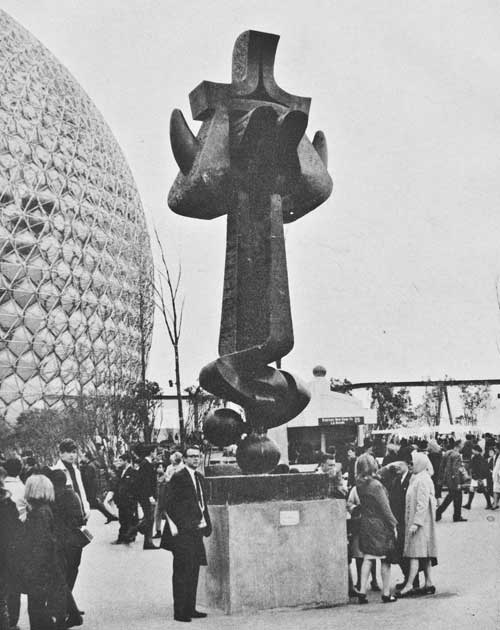Sometimes, it's just a matter of asking the question.
When Dr. Van E. Christou (LLD '84) and his family attended Expo '67 in Montreal, they had no idea they'd be coming home with a 17-foot tall, 1,800 kilogram (4,000 pounds) souvenir for the University of Lethbridge. Then again, the fledgling U of L was not your typical university and as an original board member, Christou had the kind of maverick spirit that opened doors and got things done.
"When we were walking around Expo I was really struck by the art throughout the site, and I noticed that each sculpture was owned by the House of Seagrams," says Christou. "I called up our president, Sam Smith, and asked if he could get me a meeting with one of their representatives. I spent the next afternoon with Charles Bronfman, the CEO. At the end of our talk, I asked him what they were doing with all the sculptures when Expo was finished and he said they had no plans."
So Christou made his pitch, telling the story of this new centennial university and how a significant art piece would make a wonderful gift to celebrate its opening.
"He said go ahead, choose whatever one you want," says Christou.

With family in tow, Christou and his wife Helen went shopping.
"We had four children ranging from eight years down, and they all came with me, and we went back and forth across the entire Expo site," recounts Christou. "I eventually narrowed it down to two pieces, one from Sorel Etrog and another from Louis Archambault, a French Canadian artist. I chose Moses because I thought it would fit better with Erickson's University Hall."
Created by Romanian-born, Canadian sculptor Etrog, it was commissioned by the corporation that operated Expo '67. Etrog actually created three such sculptures, cast in bronze and hollow, with the others currently situated in Los Angeles, Cal. and Tel Aviv, Israel.
It originally resided near the American pavilion on the Expo '67 site.
"People used to gather around it and meet around it when it was out in the open, it has that kind of presence," says Christou. "It is a very powerful piece. If you walk around it, it really does something to you, it's very strong. I just thought it was outstanding and that's why I picked it."
Moses was originally installed at the University's Lethbridge Junior College campus before being moved to the west side in 1972 and mounted outside the entrance to University Hall. For more than four years Moses braved the weather as best he could, but even 4,000 pounds of bronze can buckle when confronted with southern Alberta Chinook winds that vibrated it so consistently, it developed a series of cracks in its base. In the fall of 1977, Moses was taken down and shipped off to Dressor Clark Industries for substantial repairs. A heavier base was constructed, cracks in its exterior were sealed and Moses was ready for his next, and final, journey. In 1981, as the Centre for the Arts was nearing completion, he was lowered through an unfinished roof to his current resting place.
"It's interesting that it's the first piece that we got for the art collection," says Christou of an internationally renowned collection that now has greater than 13,000 pieces. "It allowed me to talk the other members of the board into spending money to start the art collection. It was a tough time and money was scarce but I managed to wine and dine them long enough to get it passed and that's how we got the collection started."
GET THE FACTS
· Moses was originally cast in Florence, Italy before being transported to Montreal
· Seagrams paid for the entire cost of shipping Moses to Lethbridge and for engineers to erect the sculpture on its original site
· Etrog, who was born in Romania in 1933 but left to study at the Tel Aviv Art Institute in 1950, later moved to New York City then Toronto. He gained Canadian citizenship in 1966 and passed away on Feb. 26, 2014
· Etrog also designed the Canadian film award now known as the 'Genie'. It was originally called the 'Etrog'
· The University has a total of five Etrog pieces in the Art Collection
· Moses underwent further repairs in 2005, when additional supports were installed near the top of the sculpture after it was found to have moved during regular cleaning
· Dr. Van E. Christou was recently named the 2014 Lethbridge Citizen of the Year
This story first appeared in the March 2012 issue of the Legend. For a look at the full issue in a flipbook format, follow this link.
